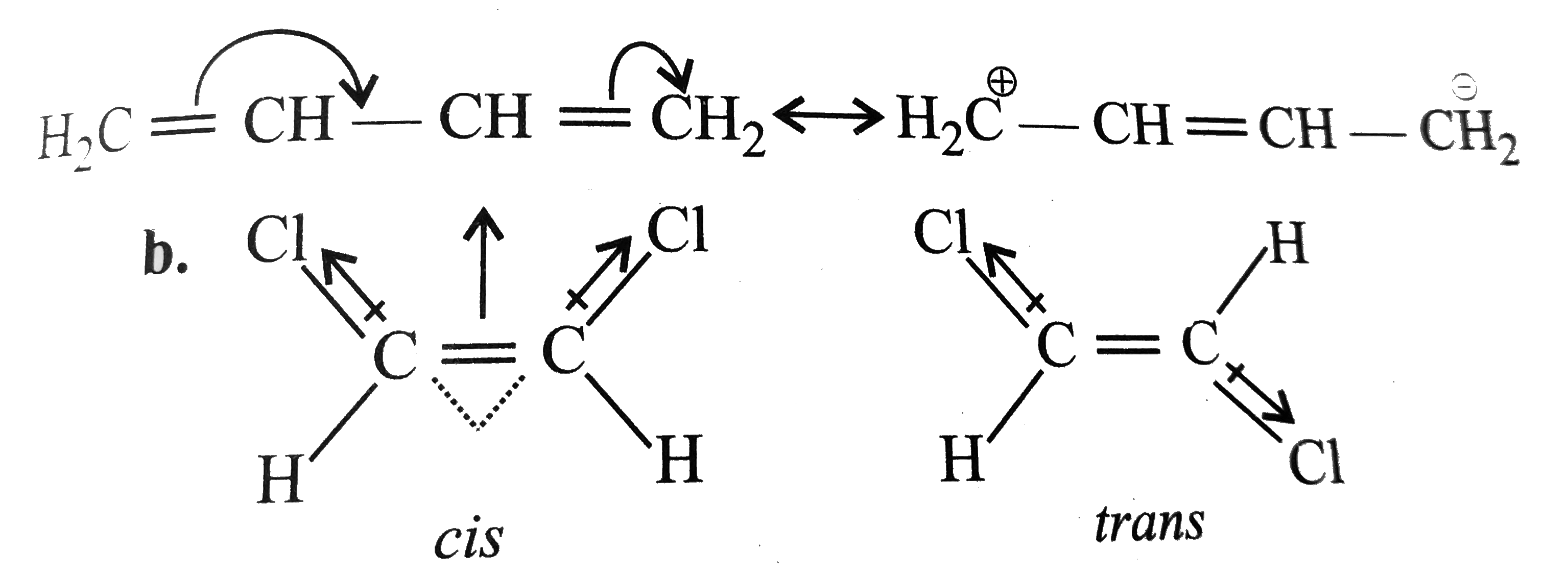Expalin the following
(a) The central C−C bond in Buta 1,3 diene is shorter than that of n-butane
(b) Why the dipole moment of cis−1,2 dichloroethene is greater than that of trans -1,2 -dichloroethene
(c ) CIFΘ2 is linear, but CIF⊕2 is bent
(d )Two different bond lengths are observed in PF5 but only one bond lenght is observed in SF6 .
Due to resonance in conjugated dienes In the the cis compound the dipoles do not cancel each other and the resultant is a higher value while in the trans compound C−CI bond dipoles are equal and opposite and hence cancel each other and μ=0
(c ) In CIFΘ2 ion the central chlorine atom involves sp3 d hybridisation to have minimum electronic repulsion Three lone pairs should be in equatorial position to give linear shape to the ion Whereas in case of CIF⊕2 ion the central chlorine atom involves sp3 hybridisation having two lone pairs resulting in bent shape for the ion (bond angle less than 109∘28' due to bp-lp repulsion)
(d) PF5 has trigonal pyramidal structure sp3 d hybridisation of central atom) in which bond angles are 90∘ and 120∘ respectively and there are two types of bonds axial and equatorial (axial being longer than equatorial) In case of SF6 the structure is octahedral (sp3 hybridisation of the central atom S) resulting only one type of bond bond angle 90∘ and one type of bond lenght
 .
.
Topper's Solved these Questions
- CHEMICAL BONDING AND MOLECULAR STRUCTUREBOOK - CENGAGE CHEMISTRY ENGLISHCHAPTER - CHEMICAL BONDING AND MOLECULAR STRUCTUREEXERCISE - Exercises Linked Comprehension
43 Videos
- CHEMICAL BONDING AND MOLECULAR STRUCTUREBOOK - CENGAGE CHEMISTRY ENGLISHCHAPTER - CHEMICAL BONDING AND MOLECULAR STRUCTUREEXERCISE - Exercises Multiple Correct(Chemical Bonding )
7 Videos
- CHEMICAL BONDING AND MOLECULAR STRUCTUREBOOK - CENGAGE CHEMISTRY ENGLISHCHAPTER - CHEMICAL BONDING AND MOLECULAR STRUCTUREEXERCISE - Ex 2 .2 Subjective (Molecular Orbital Theory)
4 Videos
- ATOMIC STRUCTUREBOOK - CENGAGE CHEMISTRY ENGLISHCHAPTER - ATOMIC STRUCTUREEXERCISE - Concept Applicationexercise(4.3)
19 Videos
- CHEMICAL EQUILIBRIUMBOOK - CENGAGE CHEMISTRY ENGLISHCHAPTER - CHEMICAL EQUILIBRIUMEXERCISE - Subjective type
1 Video
Similar Questions
Give reasons for the following in one or two sentences ' The central carbon− carbon bond in 1,3−butadiene is shorter than that in n− butane '.
View SolutionExplain:
Dipole moment of MeCH2CHO (propanal) (2.5D)
is greater than that of but−1-ene (0.3D).
View SolutionThe electronegaivity difference between N and F is greater than that between N and H yet the dipole moment of NH3 ( 1 .5 D) is larger than that of NF3(0.2D). This is because :
View SolutionGive reasons:
(i). C−Cl bond length in chlorobenzene is shorter than C−Cl bond length in CH3−Cl
(ii). The dipole moment of chlorobenzene is less than of cyclohexyl chloride.
(c). SN1 reactions are accompanied by racemisation is optically active alkyl halides.
View SolutionAccount of the following observations
(a) Ammonium salts are more soluble in water than the corresponding sodium salts
(b) BeCI2 is linear but SnCI2 is angular
(c ) F2 gas is more reactive than CI2 gas
(d) The bond lengths of both O−O bonds in ozone are equal .
View SolutionLet the observations xi(1≤i≤10) satisfy the equations, 10∑i=1(xi−5)=10 then the mean of xi(1≤i≤10) is
a)1
b)2
c) 3
d) 6
View SolutionStatement-1 : Dipole moment of NF3 is less than that of NH3.
Statement-2 : Polarity of N−F bond is less than that of N−H bond.
View SolutionThe value of ∫10ex2dx is
(A) less than e (B) greater than 1 (C) less than e but greater than 1 (D) all of these
View SolutionStatement-1: H2O2 is more polar than H2O
Statement-2: D2O has higher boiling point than H2O
Statement-3: H2 bond bond energy is less than D2.
View SolutionConsider the following statements and arrange in the order of true/false as given in the codes.
S1:The hydrogen bond in salt, KHF2 is stronger than that in gasous HF.
S2 :The dipole moment of CH3F is greater than that of CH3Cl.
S3:sp2 hybrid orbitals have equals s and p character.
S4:Two types of bond present in B2H6 are covalent and three centre-two electrons bonds.
View Solution
